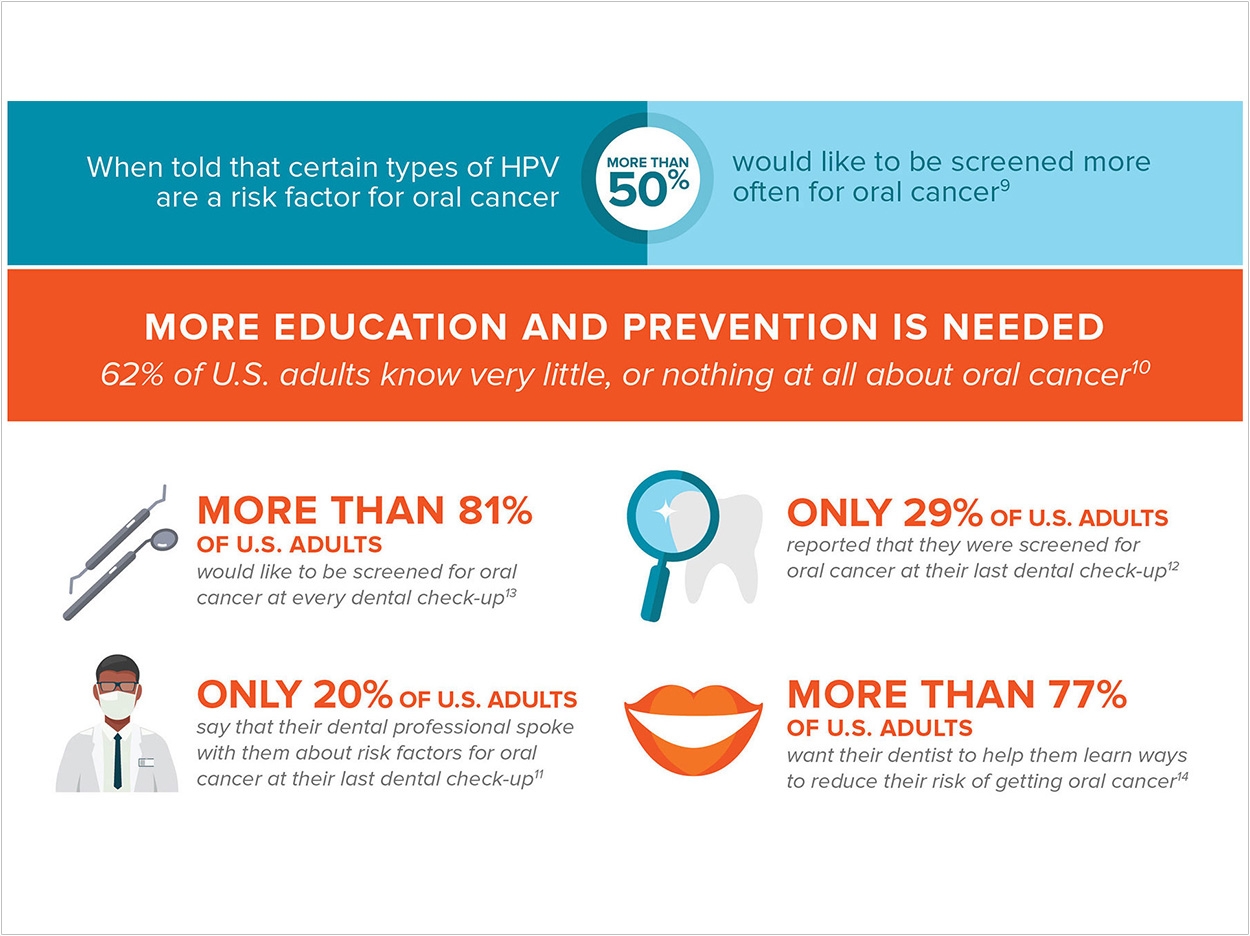
More than 49,750 people in the United States will be diagnosed with oral cancer this year, according to Vigilant Biosciences. Yet 62% of adults in the US know very little or nothing at all about the disease—including cancer of the oral cavity, tongue, larynx, and pharynx—and only 29% report being screened for oral cancer at their last dental checkup, according to a survey conducted by the company in collaboration with the Head and Neck Cancer Alliance, Oral Cancer Foundation, and Support for People with Oral and Head and Neck Cancer (SPOHNC).
Released in support of Oral Cancer Awareness Month, the online survey polled more than 500 adults in the United States between the ages of 18 and 75 years on their knowledge and perceptions of oral cancer and oral cancer screenings. It found that more than 77% of adults in the United States want to learn more about how to reduce their risk for oral cancer and are interested in simple screening tools that test for early indicators of oral cancer.
The survey also revealed how little US adults know about the various risk factors for oral cancer, particularly the connection between oral cancer and oral human papillomavirus (HPV). While the Centers for Disease Control and Prevention report that up to 70% of oropharyngeal cancers may be associated with HPV, the survey found that 59% of adults in the United States are not aware that HPV is a risk factor for oral cancer.
“Oral, head, and neck cancer—particularly HPV-related—is increasing at an alarming rate and, given that the symptoms are hard to identify, many people are not diagnosed until the cancer has progressed to a late stage,” said Holly Boykin, executive director of the Head and Neck Cancer Alliance. “Early detection is critical and may impact the complexity of the treatment of these cancers. By working together with other advocacy organizations and the medical and dental community, we can help save lives through early detection and a commitment to raising awareness about these cancers.”
While 29% of those surveyed recall being screened for oral cancer at their last dental checkup, 81% would like to be screened at every checkup. Also, 79% would like the option of being screened for oral cancer with a simple test that collects samples via a saline rinse and flags early indicators of oral cancer. And, only 5% have ever requested an oral cancer exam from a dental or medical professional. Of those who have not, most did not know that they should or had never thought about it.
Meanwhile, tobacco use and alcohol consumption are associated with the highest risks for developing oral cancer. While most survey respondents recognized tobacco use as a leading risk factor for oral cancer, many were not aware of additional risk factors, such as certain types of the HPV virus. Of those diagnosed with HPV, only 36% considered themselves at risk for oral cancer. Less than 5% of those surveyed had discussed the relationship between HPV and oral cancer with their dental professional. And, only 20% said their dental professional spoke with them about risk factors for oral cancer at their last appointment.
Perhaps most significantly, respondents underestimated the death rate for oral cancer. Only 17% of those surveyed were aware that 40% of people diagnosed with oral cancer die within 5 years, due to late-stage diagnosis, with most believing the 5-year survival rate to be much higher. Early detection in stage I or II yields survival rates of up to 90%. If diagnosed with oral cancer, 69% of respondents would seek out a support network via email, phone, online, or in person, and more than 36% of respondents would be interested in all these supports.
“Patients diagnosed with this disease can find support, hope, and encouragement through SPOHNC’s many resources and programs specifically designed for this patient population,” said Mary Ann Caputo, executive director of SPOHNC. “SPOHNC’s long history of more than 25 years understands the importance of the value of its programs and resources to this patient population. Any steps to raise awareness of oral, head, and neck cancer will help to increase the survival rate and quality of life from earlier intervention.”
“Our survey this year found that these is still much work to be done around increasing awareness of oral cancer and oral cancer risk, particularly around the various risk factors for oral cancer,” said Matthew H. J. Kim, founder, chairman, and CEO of Vigilant Biosciences. “Working together with medical and dental health professionals, as well as industry advocacy groups, we can reduce the number of late stage diagnoses by educating consumers at risk and developing simple, accurate, and cost-effective tools that can help detect oral cancer in its early stages, before it’s too late.”
Related Articles
Awareness Is the Key to Fighting Oral Cancer
When an Oral Cancer Diagnosis Hits Home
Is Your Practice Really Dedicated to the Early Discovery of Oral Cancer?


